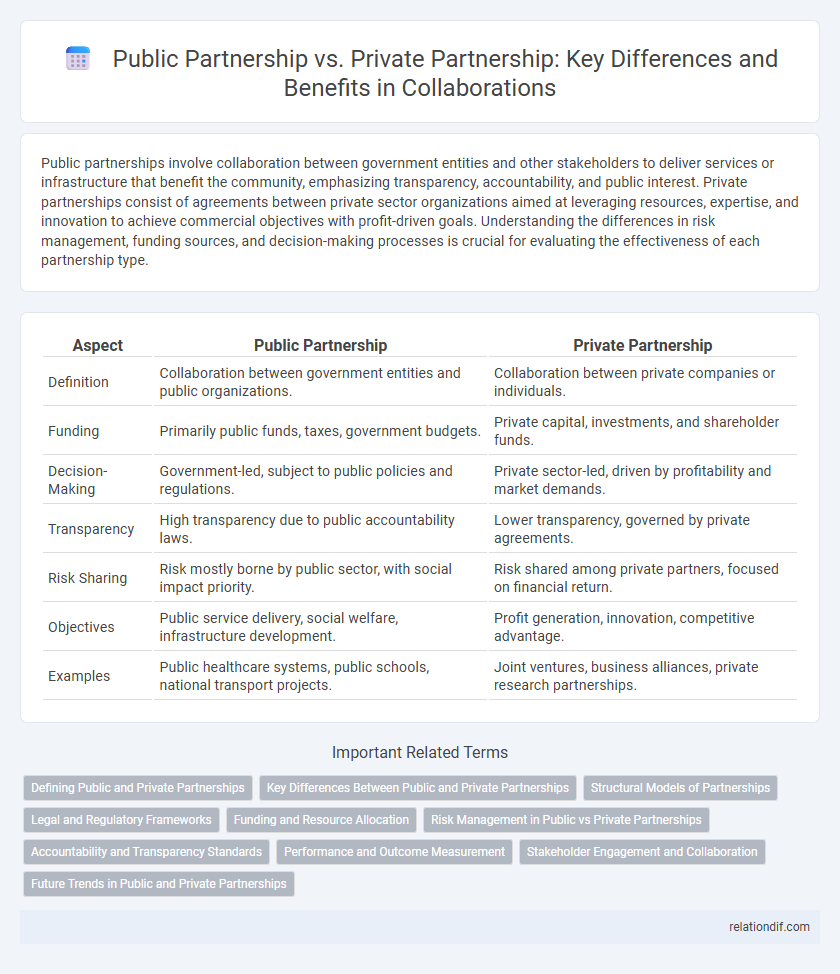Public partnerships involve collaboration between government entities and other stakeholders to deliver services or infrastructure that benefit the community, emphasizing transparency, accountability, and public interest. Private partnerships consist of agreements between private sector organizations aimed at leveraging resources, expertise, and innovation to achieve commercial objectives with profit-driven goals. Understanding the differences in risk management, funding sources, and decision-making processes is crucial for evaluating the effectiveness of each partnership type.
Table of Comparison
| Aspect | Public Partnership | Private Partnership |
|---|---|---|
| Definition | Collaboration between government entities and public organizations. | Collaboration between private companies or individuals. |
| Funding | Primarily public funds, taxes, government budgets. | Private capital, investments, and shareholder funds. |
| Decision-Making | Government-led, subject to public policies and regulations. | Private sector-led, driven by profitability and market demands. |
| Transparency | High transparency due to public accountability laws. | Lower transparency, governed by private agreements. |
| Risk Sharing | Risk mostly borne by public sector, with social impact priority. | Risk shared among private partners, focused on financial return. |
| Objectives | Public service delivery, social welfare, infrastructure development. | Profit generation, innovation, competitive advantage. |
| Examples | Public healthcare systems, public schools, national transport projects. | Joint ventures, business alliances, private research partnerships. |
Defining Public and Private Partnerships
Public partnerships involve collaborations between government entities and public institutions aimed at delivering community services or infrastructure projects, often funded by taxpayers. Private partnerships refer to alliances between private sector companies focused on profit-driven ventures, innovation, or market expansion without direct government involvement. Defining these partnerships centers on ownership, funding sources, accountability frameworks, and strategic objectives that differentiate public-social goals from private-commercial interests.
Key Differences Between Public and Private Partnerships
Public partnerships often involve government entities collaborating with public agencies to deliver services or infrastructure, emphasizing transparency, regulatory compliance, and public accountability. In contrast, private partnerships primarily consist of collaborations between private sector companies focused on profit generation, operational efficiency, and flexible decision-making models. Key differences include funding sources, risk distribution, management structures, and the level of public oversight.
Structural Models of Partnerships
Public partnerships typically follow formal structural models like Public-Private Partnerships (PPPs), which integrate government agencies with private sector entities to deliver public services or infrastructure projects using clearly defined roles and risk-sharing frameworks. Private partnerships often adopt flexible structures such as joint ventures or strategic alliances, emphasizing shared ownership, operational control, and profit distribution without direct government involvement. Structural models in public partnerships emphasize regulatory compliance and public accountability, whereas private partnerships prioritize agility, innovation, and market-driven decision-making processes.
Legal and Regulatory Frameworks
Public partnerships operate under stringent legal and regulatory frameworks defined by government statutes and public accountability standards to ensure transparency and compliance. Private partnerships are governed by more flexible contractual agreements and varying state laws, allowing for tailored operational procedures but requiring strict adherence to commercial codes and fiduciary duties. Understanding these distinct legal contexts is crucial for navigating liability, governance, and dispute resolution in each partnership type.
Funding and Resource Allocation
Public partnerships primarily rely on government funding, enabling access to substantial financial resources allocated through taxpayer money and public grants. Private partnerships attract investment from corporations and individual investors, optimizing resource allocation based on profit incentives and market-driven strategies. Efficient funding and resource management in both types of partnerships are critical for achieving project goals and sustaining long-term operations.
Risk Management in Public vs Private Partnerships
Risk management in public partnerships typically involves stringent regulatory compliance and accountability to taxpayers, ensuring transparency and minimizing political risks. Private partnerships prioritize flexibility and speed in decision-making processes, focusing on mitigating financial and market risks through dynamic contract structures and investor protections. Both partnership types employ risk-sharing mechanisms, but public partnerships emphasize social and environmental safeguards, while private partnerships concentrate on profitability and operational efficiency.
Accountability and Transparency Standards
Public partnerships typically enforce stringent accountability and transparency standards mandated by government regulations, ensuring thorough oversight and public access to information. Private partnerships prioritize internal governance mechanisms but may lack the same level of mandatory disclosure, potentially reducing transparency to external stakeholders. Enhanced accountability in public partnerships fosters trust among citizens, while private entities rely more heavily on contractual agreements to maintain responsibility.
Performance and Outcome Measurement
Public partnerships often rely on standardized metrics and government-mandated frameworks to assess performance and outcome measurement, ensuring accountability and transparency for taxpayers. Private partnerships typically implement more flexible, data-driven approaches focused on efficiency and return on investment, adapting rapidly to market changes. The integration of both models can enhance comprehensive performance evaluation by combining regulatory compliance with innovative, outcome-oriented strategies.
Stakeholder Engagement and Collaboration
Public partnerships typically involve a broad range of stakeholders, including government agencies, community groups, and the public, fostering inclusive engagement through transparent communication and consensus-building processes. Private partnerships often emphasize direct collaboration between businesses and select partners, leveraging specialized expertise and streamlined decision-making to achieve targeted objectives. Effective stakeholder engagement in both models relies on clear roles, mutual trust, and continuous dialogue to ensure alignment of goals and sustainable outcomes.
Future Trends in Public and Private Partnerships
Future trends in public and private partnerships emphasize increased integration of technology, such as artificial intelligence and blockchain, to enhance transparency and efficiency in project management. Sustainable development goals drive collaborations towards environmentally friendly infrastructure and renewable energy projects, aligning economic growth with social responsibility. Data-driven decision-making and flexible contract models are becoming predominant, enabling adaptive partnerships that respond to evolving market and community needs.
public partnership vs private partnership Infographic

 relationdif.com
relationdif.com